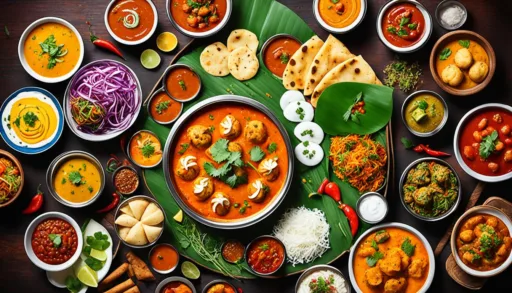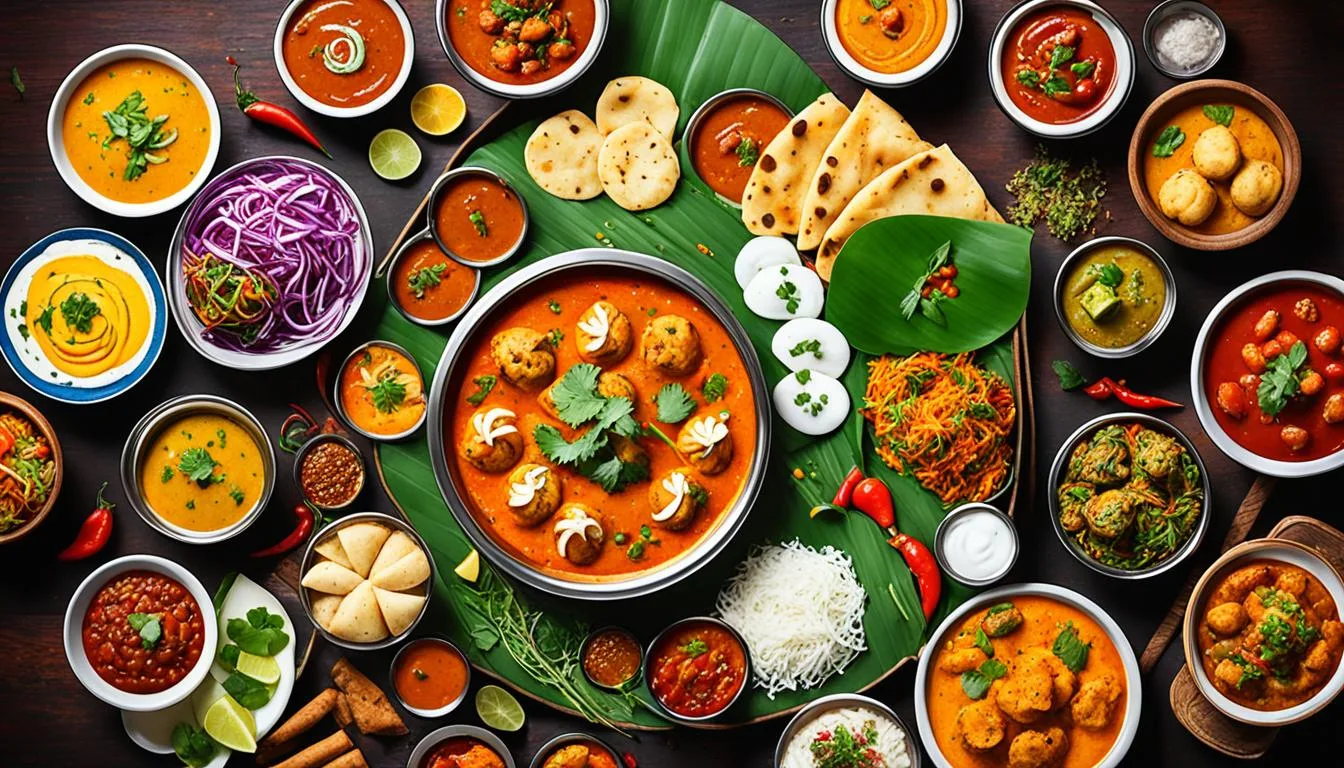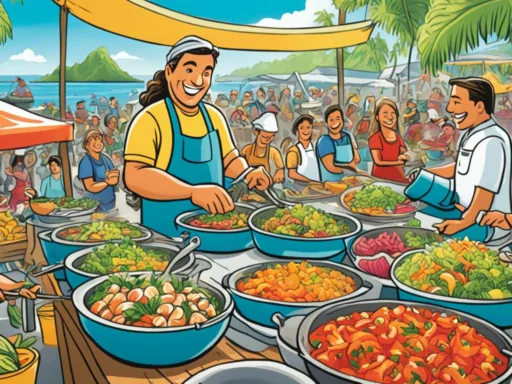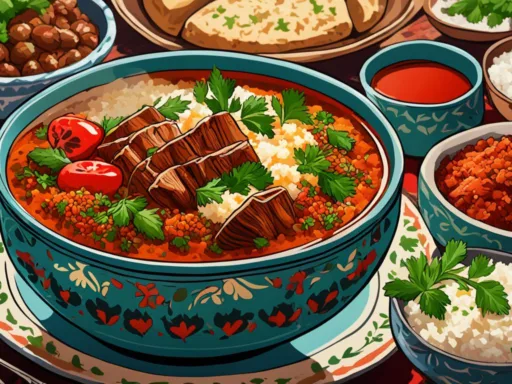Far beyond the towering majesty of Everest lies a different kind of summit – one of culinary expanse and exploration. A Nepalese Food Tour unfurls a rich tapestry of vibrant food landscapes, each thread a flavorful story of its own. Imagine trekking through the aromatic alleyways of authentic Nepalese dishes, where the unique mingling of spices reveals a dynamic gastronomic terrain. Are you prepared to embark on a culinary adventure in Nepal and discover the diverse dishes that define the rich cuisine of Nepal?
Key Takeaways
- Immerse into the vibrant food landscape of Nepal with a guided culinary adventure.
- Engage your senses with the aromatic spices and diverse dishes of Nepal.
- Experience the heart and soul of local culture through authentic Nepalese dishes.
- Uncover the secrets behind the rich cuisine of Nepal on a Nepalese Food Tour.
- Revel in the fusion of flavors hailing from the mountainous terrains to the lowlands.
- Discover how geographical diversity shapes the culinary traditions of Nepal.
Nepalese Food Tour: A Tapestry of Flavors
Embark on a Nepali cuisine exploration and immerse yourself in the rich culinary heritage that is woven with Tibetan influences and Indian influences. This journey through flavors is not just about satiating your appetite; it’s an adventure that captures the essence of Nepal’s diverse culture and its connection to the land.
Embracing the Blend of Tibetan and Indian Influences in Nepali Cuisine
Nepal, nestled amidst the great Himalayas and lush lowlands, has a cuisine that is as varied as its geography. Tibetan influences manifest in the form of momos (dumplings) and thukpa (noodle soup), while Indian influences are evident in the use of curries and tandoor-cooked meats. The intermingling of these culinary traditions presents a palate-enriching experience that is unique to this Himalayan nation.
Hearty Mountain Fare and Aromatic Spices: The Staples of a Nepalese Food Tour
Nourishing and hearty mountain fare forms the backbone of traditional Nepalese food. Ingredients are often sourced from local terrains, with dishes boasting an array of aromatic spices which infuse robust flavors. Seasonings such as cumin, coriander, ginger, and turmeric are the hidden heroes that elevate a simple meal into an extraordinary local food experience in Nepal.
Authentic Nepalese Dishes Offering a Delight to Every Palate
Discover authentic dishes that offer delights for every palate. Dal bhat, the quintessential Nepali meal, is vastly different from snackable street foods like spicy chatpate. Below is a table showcasing some of the authentic Nepalese dishes to look out for:
| Region | Dish | Main Ingredients | Flavor Profile |
|---|---|---|---|
| Tarai | Dal Bhat | Lentils, Rice, Vegetables | Savory, Mildly Spiced |
| Kathmandu Valley | Momo | Dough, Meat/Vegetables | Savory, Spiced |
| Mountain Regions | Yak Cheese | Milk (Yak) | Rich, Umami |
| All Regions | Sel Roti | Rice Flour, Sugar | Sweet, Crispy |
Nepal’s culinary scene is a beautiful blend of tradition and innovation. As you wander through this Himalayan paradise, let the flavors guide you through a cultural narrative that is as diverse as the landscapes you traverse. With each morsel of savory momo or fragrant dal, you connect deeper with the heartbeat of Nepal—a gastronomic adventure you will not forget.
The Quintessential Dal Bhat: Understanding Nepal’s National Dish
The heart of Nepali cuisine beats with the rhythm of Dal Bhat, the national dish of Nepal. Its comforting simplicity and nutritional balance provide an authentic window into the daily lives and cultural heritage of the Nepalese people. Dal Bhat encapsulates traditional Nepalese recipes, making it a complete meal that many consider a cornerstone of authentic Nepalese dishes.
At its core, Dal Bhat is an exercise in unity, bringing together a variety of flavors and textures that mirror Nepal’s diverse agricultural practices. The dal portion is a fragrant lentil soup that infuses a rich concoction of local spices, a base for adding different seasonal vegetables, making it vibrant and adaptable.

Dal Bhat power, 24 hour – A popular Nepali saying highlighting the dish’s reputed ability to provide sustained energy.
This guide delves into the components that make up the classic Dal Bhat meal:
- Bhat (Rice): Typically steamed, the Bhat provides a neutral foundation for the meal’s robust flavors.
- Dal (Lentil Soup): Ranging from yellow to black lentils, Dal is the protein-rich core of the dish.
- Tarkari (Vegetable Curry): Often a mix of seasonal vegetables, Tarkari adds vital nutrients and diversity in texture.
- Achar (Pickle): Spicy and tangy, Achar introduces a sharp contrast that elevates the overall taste.
| Ingredient | Description | Health Benefits |
|---|---|---|
| Rice (Bhat) | Steamed grain, ordinarily white, essential for calories and energy. | Source of carbohydrates; provides quick energy and sustains blood sugar levels. |
| Lentil Soup (Dal) | Aromatic legume-based broth, seasoned with turmeric and cumin. | Rich in protein; supports tissue repair and muscle growth. |
| Vegetable Curry (Tarkari) | Diverse vegetables cooked with spices like mustard seeds and coriander. | Offers vitamins and minerals; boosts immune system. |
| Spicy Pickle (Achar) | Prepared with local fruits, vegetables, and an assortment of spices. | Contains antioxidants; aids digestion. |
Whether served in a modest Kathmandu eatery or a mountainous Thakali kitchen, Dal Bhat is an ever-present testament to its standing as the ultimate comfort food, an embodiment of Nepal’s hospitable essence. The traditional practice of second helpings, known locally as “Puratī”, ensures no guest leaves the table anything less than fully satisfied.
Exploring Traditional Newari Cuisine in Kathmandu Valley
Within the heart of Nepal, the intricate and flavorful Newari Cuisine serves as a cornerstone of Kathmandu Valley gastronomy. Rich in history and tradition, these authentic Nepalese dishes invite you on a culinary journey that speaks to the soul of local heritage. Known for their traditional Newari recipes passed down through generations, the myriad of tastes found in this fascinating cuisine provides a feast not only for the palate but also for the senses.
As we delve into the gastronomy of the Newars, we encounter a cuisine that has been integral to festivities and day-to-day life alike. Each dish reveals a layer of the Kathmandu Valley’s rich cultural tapestry, inviting epicures and culture enthusiasts to a world of bold flavors and ceremonial delights.
Newari Feasts and Festivities: Relishing Yomari and Bara
The Newari festive scene is unimaginable without the presence of Yomari and Bara. Yomari, a sweet treasure, comprises delicate dough shaped like figs and filled with a heartwarming blend of jaggery and sesame seeds. During the festival of Yomari Punhi, these delightful packages symbolize the richness of the harvest and Newari culinary ingenuity.
In contrast, Bara’s savory canvas showcases the versatility of Newari cuisine. These delicate lentil patties often come adorned with various toppings, from minced meat to egg or finely chopped vegetables, each variant offering a unique flavorful experience.
Savoring the Spiciness of Choila: A Newari Delight
Choila’s fiery zest is an explosion of tastes synonymous with Newari festive plates. This delectable dish involves marinated and grilled meat, commonly buffalo, laced with a range of spices that reflect the audacity of Newari flavors— a testament to the community’s love of spice and celebration of texture in their traditional preparations.
No exploration of Kathmandu Valley’s gastronomy is complete without indulging in these specialties, which honor the deep-rooted culinary customs of Newari culture.
The table below offers insight into a few hallmark Newari dishes, featuring the main ingredients that contribute to their singular profiles:
| Dish | Main Ingredients | Flavor Profile | Typical Occasion |
|---|---|---|---|
| Yomari | Rice flour, jaggery, sesame seeds | Sweet, rich | Yomari Punhi festival |
| Bara | Lentils, herbs, optional toppings like meat or egg | Savory, versatile | Various celebrations and daily fare |
| Choila | Grilled buffalo meat, spices, mustard oil | Spicy, bold | Sithi Nakha, other Newari festivals |
Each of these dishes connects us more profoundly to the hospitality and community spirit of the Newari people. They invite us to gather, celebrate, and immerse fully in the authentic taste of Kathmandu Valley gastronomy— a culinary heritage that endures as one of the pearls of Nepalese culture.
Thakali Delicacies from the Annapurna Region
The Annapurna region of Nepal is not only famous for its stunning vistas but also for its Thakali Cuisine, a delicious chapter in the country’s culinary story. Food connoisseurs on a culinary adventure in Nepal often rave about the authenticity that Thakali dishes bring to their palates. With a taste that’s as distinct as the region itself, these authentic Nepalese dishes form an integral part of any gastronomic expedition.
A traditional Thakali meal is a symphony of flavors and nutrients, epitomizing the agricultural bounty and environmental adaptations of the region. One of the iconic Thakali dishes is Dhido, an energy-dense dish prepared with local grains like buckwheat or millet, perfectly catering to the demands of the mountainous lifestyle. Another culinary masterpiece is the Gundruk, a fermented leafy vegetable preparation that encapsulates the art of preserving food in the Himalayas.
Moreover, the Annapurna region is home to a unique variety of apple, and the locals have mastered the art of distilling this fruit into a fine brandy, a testament to the innovative spirit of the Thakali people and their harmonious relationship with nature.
- Dhido – A fortifying meal indicative of local agricultural practices
- Gundruk – The taste of preserved heritage in a leafy delicacy
- Thakali Apple Brandy – A heartening spirit to lift the senses
Embracing the Thakali cuisine offers a deeper appreciation of the Annapurna region’s culture, one that thrives on simplicity and sustainability. Exploring these dishes during your visit is sure to enrich your culinary adventure in Nepal.
Whether you’re trailblazing the Annapurna Circuit or wandering through the stone-paved lanes of a Thakali village, the local cuisine promises a heartwarming experience that illuminates the resilient and nurturing essence of the Himalayas. So, indulge in these regional delicacies and let the Thakali flavors tell their ancient, storied tale.
Culinary Adventure in Nepal: Street Food Sensations
Embarking on a food tasting tour in Nepal is a voyage of discovery into a world where the streets are alive with the aroma of spices and the sizzle of fresh cooking. Venturing into the lively alleyways of the Kathmandu Valley, one can find the true essence of local street food, offering a symphony of flavors to delight every palate.
From Momos to Jalebi: Diverse Nepalese Street Food Delights
With each step through Nepal’s bustling markets, food lovers are greeted by the sight of vendors skillfully preparing a variety of Nepalese street food delights. The ever-popular momos, savory dumplings filled with meat or vegetables and accompanied by tangy dipping sauce, are a must-try staple. Equally enticing is the sweet spiral of jalebi, a crispy, sugary treat that provides a divine contrast to the savory selections.

Nepal’s Street Food: A Window to Local Culture and Cuisine
Nepalese street food is more than just sustenance; it’s an experience woven into the very fabric of daily life. Indulging in local staples such as alu achar, a spicy potato snack, or sel roti, a ring-shaped rice doughnut, gives visitors a glimpse into the gastronomic heart of Nepal. Every snack and dish reflects a story, a tradition, and the incredible warmth of the Nepali people, making street food an integral part of any culinary adventure in the region.
Local Food Experiences in Nepal: From Thakali to Sherpa Cuisine
Embarking on a journey to explore local food experiences in Nepal not only tantalizes the taste buds but also connects travelers to the heart of Nepali culture. The rugged terrains of the Annapurna circuit are home to the delectable Thakali cuisine, known for its balanced mix of flavor and nutrition, a necessity in the high-altitude lifestyle. Further up the trails, nestled among the Himalayan peaks, the traditional Sherpa dishes offer hearty sustenance to trekkers and locals alike.

Authentic Nepalese dishes can be experienced in a multitude of ways, but the most enriching encounters often happen in communal settings — where food is an invitation to partake in Nepalese hospitality. Imagine sharing a Thakali Thali with new friends or enjoying a steaming bowl of Sherpa stew after a day’s hike. These meals are not just about sustenance; they’re a narrative of the Nepalese way of life.
Every meal is a chapter of a story interwoven with ingredients, techniques, and traditions that have traveled along ancient trade paths, echoing the culinary heritage of Nepal.
To truly understand these remarkable cuisines, one must not simply taste but also observe. Watching a Thakali kitchen in action, with its efficient use of freshly harvested produce, or a Sherpa cook preparing a timeless recipe passed down through generations, provides invaluable insight into the significance of these dishes.
| Thakali Cuisine | Sherpa Cuisine |
|---|---|
| Dhido (Buckwheat or Millet Dough) | Thukpa (Noodle Soup) |
| Tsampa (Barley Flour Mix) | Sha Balep (Meat Stuffed Bread) |
| Gundruk (Fermented Leafy Greens) | Sherpa Stew (Vegetable and Meat Stew) |
| Thakali Thali (Assorted Platter) | Butter Tea (Tea with Yak Butter and Salt) |
Amidst all, the most compelling part of local food experiences in Nepal may well be these humble dishes, which reveal the resilience and creativity of the Nepali people. Through tasting and participating in the culinary customs of the Thakali and Sherpa communities, travelers find a connection that far surpasses the ephemeral nature of tourism, leaving a lasting impression of the region’s rich culinary artistry.
Nepalese Tea and Coffee Culture: Warm Sips in the Himalayas
Stepping into the serene world of Nepalese tea and coffee culture is an immersive journey into traditions steeped in the history of the Himalayas. In Nepal, sipping on a cup of traditional Himalayan tea is more than just a means to quench thirst; it’s an act of community, a moment of peace, and a cultural ritual that echoes the nation’s affinity for warmth and hospitality.
Himalayan Teas: Butter Tea and Beyond
The varieties of Himalayan teas tantalize the palate with their rich flavors and historical significance. Prime examples such as the vigor-instilling butter tea or the comforting Dudh Chiya are not merely beverages but are representative of the lifestyle in the highlands. They signify resilience and the nurturing spirit of the local people facing the crisp mountain air.
Cozy Retreats: Nepal’s Local Tea Houses and Coffee Shops
Across the rugged terrains, the heartwarming presence of local tea houses and coffee shops provides trekkers and tourists alike a haven to relax and rejuvenate. Within these cozy retreats, every sip of meticulously prepared tea or coffee unravels layers of Nepalese tradition, encouraging convivial interaction and a shared appreciation for the slow and savory moments in life.
| Tea/Coffee Specialty | Description | Best Enjoyed At |
|---|---|---|
| Butter Tea (Po Cha) | A rich blend of tea leaves, yak butter, and salt that energizes the body | Mountainous regions and spiritual gatherings |
| Dudh Chiya (Milk Tea) | Black tea brewed with milk and spices, offering a sweet and creamy taste | Local tea houses across Nepal |
| Coffee | Robust and aromatic Himalayan beans with a rich flavor profile | Urban coffee shops and tourist hubs |
| Herbal Teas | Infusions made with local herbs, known for their medicinal properties | Health-oriented tea spots and local healers |
The art of tea and coffee making is a cherished facet of Nepal’s culinary identity, and diving into this aspect offers a unique perspective on the daily lives of the Nepalese. Exploring this aromatic sector of Nepalese gastronomy reveals yet another layer of the country’s abundant cultural heritage.
Best Places to Eat in Nepal: Gastronomical Gems Across the Country
Embarking on a culinary voyage through Nepal transforms mere dining into an exploration of the country’s heart and heritage. From the bustling streets of Kathmandu brimming with aromatic fare to serene, hidden retreats, Nepal serves up a plate of dynamic flavors and unforgettable local food experiences. These eateries are not just points on a map but pillars of cultural storytelling and gastronomic ingenuity, welcoming both the adventurous gourmand and the curious traveler.
Charting the Best Eateries and Food Stops in Kathmandu
In Kathmandu, the search for epicurean delight leads you through winding lanes echoing with kitchen clamor and sizzling woks. The city’s eateries, some of the best places to eat in Nepal, offer a collection of cuisines that meld local ingredients with unexpected twists. Here, you can invigorate your palate with traditional Newari dishes, savor the spicy undertones of well-seasoned street food, or enjoy the modern reflections on Nepalese classics in one of the many Kathmandu eateries.
Local Recommendations: Off-the-Beaten-Path Dining Experiences
Veering off the main tourist trails, one finds the essence of Nepalese cuisine in off-the-beaten-path dining locations. These spots impart a sense of discovery, where each meal is a harmonious symphony orchestrated by family-run kitchens or innovative Nepalese chefs. Local recommendations frequently lead you to these tucked-away gastronomical gems, offering authentic engagement and a treasured taste of the best that Nepal’s culinary scene has to offer.
Conclusion
Embarking on a Nepalese Food Tour is not merely about savoring a diversity of dishes; it’s a holistic culinary journey through the heart of the Himalayas. As each dish unfolds its ingredients, it shares its history, where the blend of local favors and the stories of a people rich in culture and community are woven together. Travelers are taken beyond mere consumption into a world where every mouthful tells a story—a true testament to the immersive power and promise that these food tours hold.
The charm of Himalayan flavors is realized through more than the savors of the palate. It’s found in the bustling alleys where momos steam in crowded markets, in the quietude of a mountain teahouse with the comforting aroma of butter tea, and in the warm smiles of those who share their culinary secrets. This expedition offers not just a meal but a mosaic of experiences, integrating the local character with every bite and sip. The food tours promise an authentic encounter, an adventure that goes beyond the ephemeral to touch upon the enduring facets of Nepalese life.
As the journey concludes, those who have traversed the Nepalese gastronomic landscape carry with them more than satisfied appetites. They return with a deeper connection to the indomitable spirit of the land, its people, and the shared meals which are the cornerstone of Nepalese hospitality. For the food enthusiast, this is a voyage that will linger in the memory, rich with flavors, lessons, and the pure joy of discovering a culture through its cuisine.






